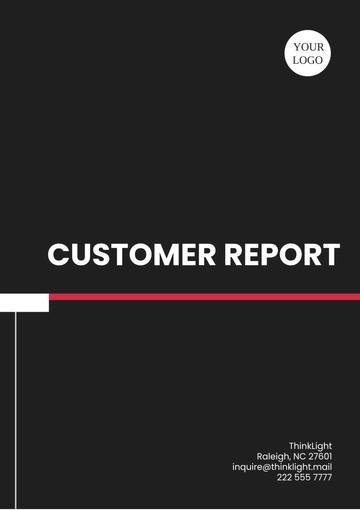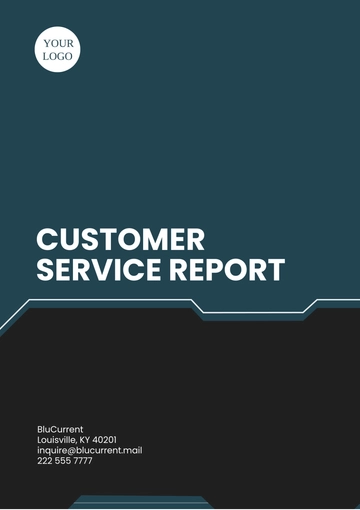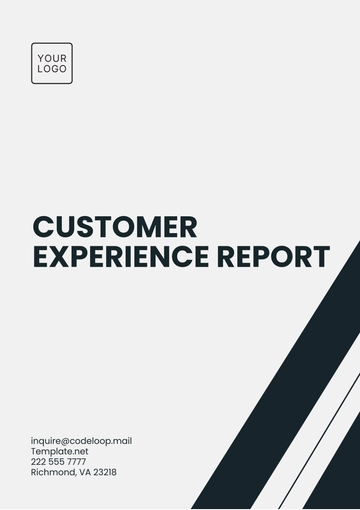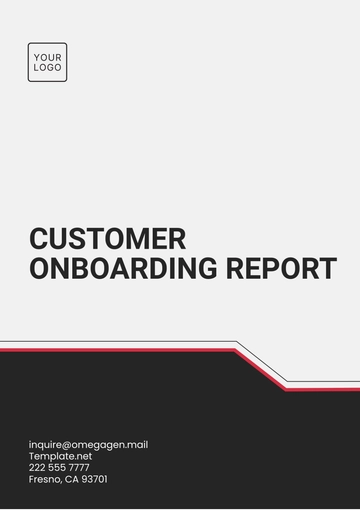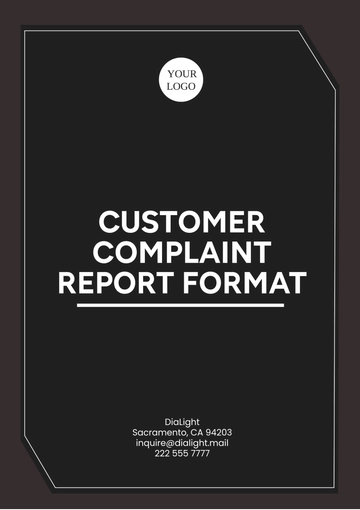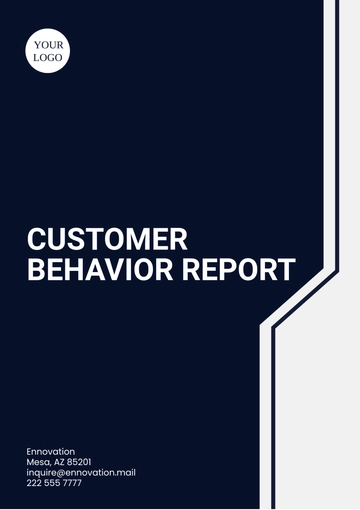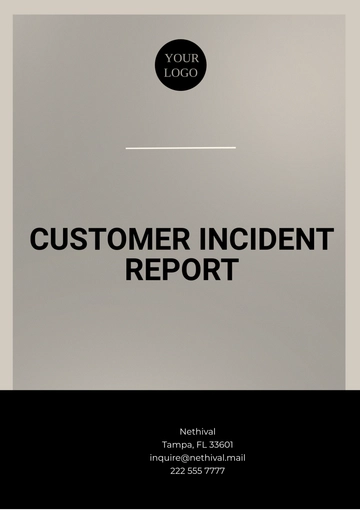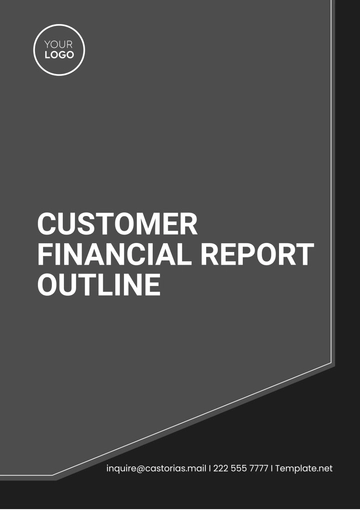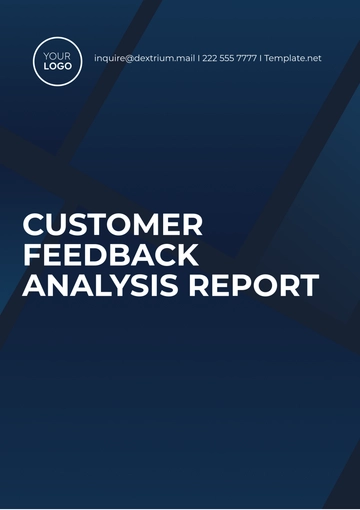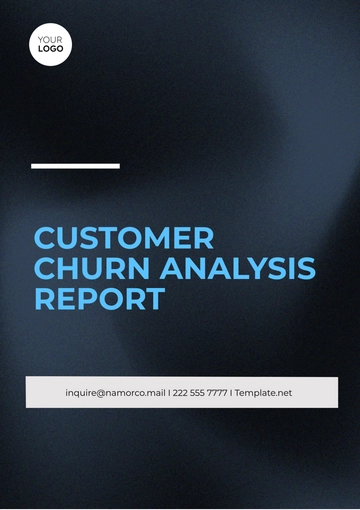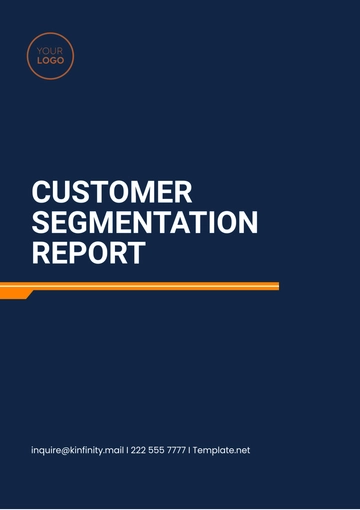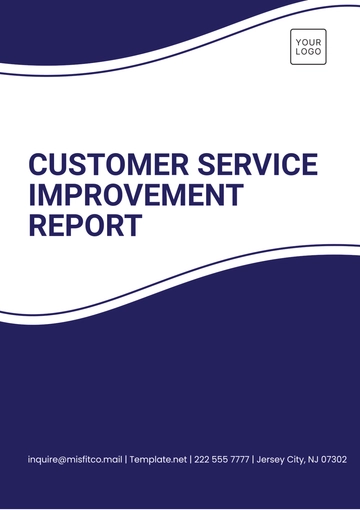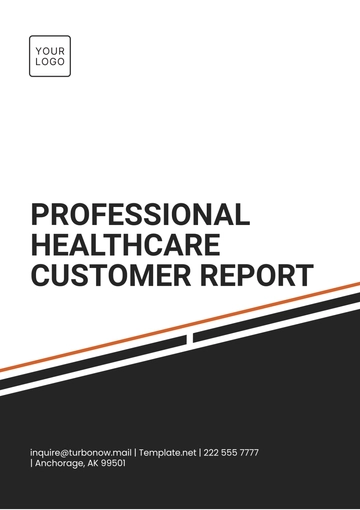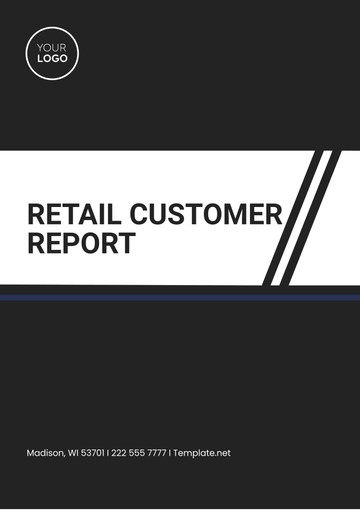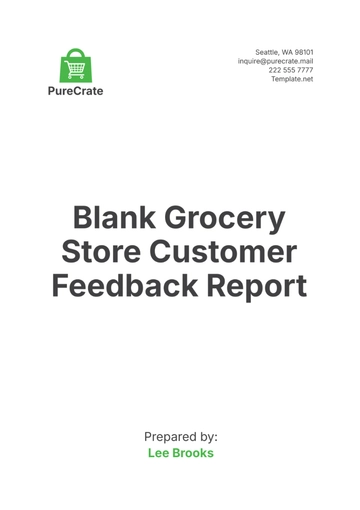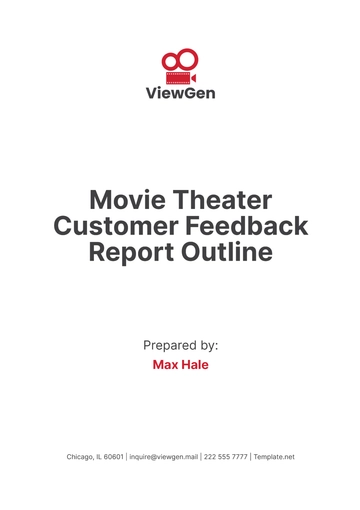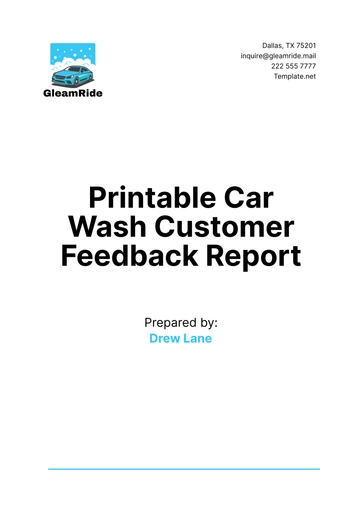Free Restaurant Customer Report

I. Executive Summary
In this Restaurant Customer Report, we aim to provide a comprehensive analysis of our customer base, their feedback, and their overall experience at our restaurant. Through detailed examination, we identified key areas of strength and opportunities for improvement. Our goal is to enhance customer satisfaction and loyalty, ensuring that we continue to meet and exceed our patrons' expectations.
High Satisfaction with Food Quality: 85% of customers rated the food quality as excellent.
Service Quality: 78% of customers expressed satisfaction with the friendliness and professionalism of our staff.
Ambiance: 70% of customers appreciated the restaurant's ambiance and decor.
Customer Retention: 60% of customers are regular patrons, visiting at least once a month.
Improvement Areas: Customers highlighted the need for faster service and more diverse menu options.
II. Introduction
The purpose of this report is to analyze customer demographics, feedback, and experiences at our restaurant. The scope of the report includes an examination of customer reviews, survey responses, and sales data collected over the past year. We used a combination of direct feedback forms, online reviews, and data from our loyalty program to compile this comprehensive analysis. Our methodology involved quantitative analysis of survey data and qualitative analysis of open-ended customer comments.
III. Customer Demographics
Understanding the demographics of our customers is crucial for tailoring our services and marketing efforts. The following table provides a breakdown of our customer demographics based on age, gender, geographic location, income level, and dining preferences.
Category | Percentage |
|---|---|
Age Distribution | |
Under 18 | 10% |
18-24 | 15% |
25-34 | 25% |
35-44 | 20% |
45-54 | 15% |
55 and above | 15% |
Gender Breakdown | |
Male | 48% |
Female | 52% |
Geographic Location | |
Local (within 10 miles) | 60% |
Nearby cities (10-50 miles) | 30% |
Out-of-town (50+ miles) | 10% |
Income Levels | |
Below $30,000 | 20% |
$30,000 - $50,000 | 25% |
$50,000 - $75,000 | 30% |
$75,000 - $100,000 | 15% |
Above $100,000 | 10% |
Dining Preferences | |
Casual Dining | 40% |
Fine Dining | 30% |
Family-Friendly | 20% |
Quick Bites | 10% |
IV. Customer Feedback
Collecting and analyzing customer feedback is vital for understanding their satisfaction levels and identifying areas for improvement. We gathered customer reviews from various sources, including in-house feedback forms, online review platforms, and social media comments. The table below summarizes the overall ratings and feedback percentages from our customers.
Common compliments from customers include the high quality of food, friendly and professional service, and pleasant ambiance. However, some customers have pointed out the need for faster service and more diverse menu options as areas for improvement.
V. Customer Experience Analysis
A. Service Quality
Service quality is a crucial factor in customer satisfaction. We assessed various elements of service quality, including staff friendliness, promptness, and professionalism.
Service Quality Criteria | Rating (%) |
|---|---|
Friendliness | 80% |
Promptness | 75% |
Professionalism | 78% |
Overall, 78% of customers are satisfied with our service quality. Customers particularly appreciate the friendliness and professionalism of our staff. However, there is a need to improve promptness to enhance the overall dining experience.
B. Food Quality
Food quality is one of our restaurant's strongest attributes. We evaluated the taste, presentation, and variety of our menu items.
Food Quality Criteria | Rating (%) |
|---|---|
Taste | 90% |
Presentation | 85% |
Variety | 80% |
Our food quality received high ratings, with 85% of customers expressing satisfaction. The taste and presentation of our dishes are highly praised. Nevertheless, some customers have suggested expanding the variety of our menu to cater to diverse preferences.
C. Ambiance and Environment
The ambiance and environment of our restaurant significantly impact the dining experience. We examined cleanliness, decor, and noise levels.
Ambiance Criteria | Rating (%) |
|---|---|
Cleanliness | 75% |
Decor | 70% |
Noise Levels | 65% |
Our ambiance and environment are appreciated by 70% of customers. Cleanliness is generally well-regarded, but there is room for improvement in the decor and noise level management to create a more pleasant dining atmosphere.
D. Value for Money
Value for money is a critical aspect of customer satisfaction. We analyzed customer perceptions of the price-to-quality ratio of our offerings.
Value for Money Criteria | Rating (%) |
|---|---|
Price-to-Quality Ratio | 70% |
Portion Sizes | 65% |
Overall Satisfaction | 68% |
Customers rate the value for money at 65%. While most customers feel that the prices are fair for the quality of food and service provided, there is feedback indicating a need for better portion sizes and more competitive pricing to enhance overall satisfaction.
VI. Sales and Performance Metrics
A. Average Spending per Customer
The average spending per customer is a key indicator of our restaurant’s financial performance. Over the past year, the average spending per customer has been approximately $45. This figure includes the cost of appetizers, main courses, desserts, and beverages. Monitoring this metric helps us assess the effectiveness of our pricing strategy and menu offerings.
B. Peak Dining Times and Days
Analyzing peak dining times and days allows us to optimize staffing and inventory management. Our data indicates that the peak dining times are between 7:00 PM and 9:00 PM, with Friday and Saturday being the busiest days of the week. Understanding these patterns enables us to better allocate resources during high-traffic periods.
C. Popular Menu Items
Identifying popular menu items helps us understand customer preferences and refine our menu. The table below lists our top five best-selling dishes along with their sales figures.
Menu Item | Units Sold (Monthly) |
|---|---|
Grilled Salmon | 350 |
Ribeye Steak | 300 |
Caesar Salad | 280 |
Margherita Pizza | 270 |
Chocolate Lava Cake | 250 |
The Grilled Salmon and Ribeye Steak are our top-selling items, indicating a preference for premium and well-prepared dishes. The popularity of the Caesar Salad and Margherita Pizza shows a strong demand for classic options. The Chocolate Lava Cake is a favored dessert, suggesting that customers appreciate a high-quality sweet ending to their meal.
D. Revenue Generated by Different Customer Segments
Analyzing revenue by different customer segments helps us tailor our marketing strategies and enhance customer experiences. The table below provides a breakdown of revenue generated based on age, gender, geographic location, income level, and dining preferences.
Customer Segment | Percentage of Total Revenue |
|---|---|
Age Distribution | |
Under 18 | 5% |
18-24 | 15% |
25-34 | 25% |
35-44 | 20% |
45-54 | 15% |
55 and above | 20% |
Gender Breakdown | |
Male | 48% |
Female | 52% |
Geographic Location | |
Local (within 10 miles) | 60% |
Nearby cities (10-50 miles) | 30% |
Out-of-town (50+ miles) | 10% |
Income Levels | |
Below $30,000 | 10% |
$30,000 - $50,000 | 20% |
$50,000 - $75,000 | 30% |
$75,000 - $100,000 | 25% |
Above $100,000 | 15% |
Dining Preferences | |
Casual Dining | 40% |
Fine Dining | 30% |
Family-Friendly | 20% |
Quick Bites | 10% |
Revenue is predominantly generated by customers aged 25-34, indicating that this age group is our primary market. Both male and female customers contribute almost equally to our revenue. Local customers within a 10-mile radius generate the most revenue, emphasizing the importance of community engagement. Higher-income segments ($50,000 and above) are significant contributors, indicating that our pricing strategy appeals to more affluent customers. Casual and fine dining preferences dominate, highlighting the need to maintain a balance between high-quality and approachable dining options.
VIII. Comparative Analysis
Understanding how we compare with competitors helps us identify areas for improvement and leverage our strengths. We analyzed key aspects such as food quality, service, ambiance, and value for money across several local competitors. The table below provides a comparative overview.
Our restaurant excels in food quality and maintains a strong position in service quality. However, we need to focus on enhancing our ambiance and value for money to better compete with local restaurants. Our customer retention rate is comparable to the competition, indicating a loyal customer base, but there is still room for improvement.
IX. Action Plan
To address the insights gathered from this report, we have developed a comprehensive action plan aimed at enhancing the overall customer experience and boosting our restaurant's performance.
Improve Service Promptness: Implement staff training programs to enhance efficiency. Introduce a table management system to streamline service.
Expand Menu Variety: Develop new menu items based on customer feedback. Regularly update the menu to include seasonal dishes.
Enhance Ambiance: Invest in modern decor and comfortable seating arrangements. Implement noise reduction measures to create a more pleasant dining atmosphere.
Optimize Value for Money: Review pricing strategy to ensure competitive pricing. Offer value deals and promotions to attract more customers.
Boost Marketing Efforts: Increase social media presence and engagement. Implement targeted marketing campaigns to attract new customers.
Monitor and Evaluate Progress: Regularly collect and analyze customer feedback. Adjust strategies based on performance metrics and customer responses.
X. Conclusion
This report highlights our strengths and areas for improvement, providing a clear path forward to enhance customer satisfaction and drive growth. By implementing the outlined action plan, we aim to elevate the dining experience, foster customer loyalty, and solidify our position as a leading restaurant in the community. Together, we can achieve these goals and continue to delight our customers with exceptional food and service.
- 100% Customizable, free editor
- Access 1 Million+ Templates, photo’s & graphics
- Download or share as a template
- Click and replace photos, graphics, text, backgrounds
- Resize, crop, AI write & more
- Access advanced editor
Discover the Restaurant Customer Report Template from Template.net! This customizable solution empowers you to create insightful reports tailored to your restaurant's needs. With editable features and seamless customization options, it's perfect for optimizing customer insights. Effortlessly craft detailed reports with our intuitive AI Editor tool, ensuring efficiency and accuracy in your restaurant management endeavors. Elevate your analysis and enhance customer satisfaction today!
You may also like
- Sales Report
- Daily Report
- Project Report
- Business Report
- Weekly Report
- Incident Report
- Annual Report
- Report Layout
- Report Design
- Progress Report
- Marketing Report
- Company Report
- Monthly Report
- Audit Report
- Status Report
- School Report
- Reports Hr
- Management Report
- Project Status Report
- Handover Report
- Health And Safety Report
- Restaurant Report
- Construction Report
- Research Report
- Evaluation Report
- Investigation Report
- Employee Report
- Advertising Report
- Weekly Status Report
- Project Management Report
- Finance Report
- Service Report
- Technical Report
- Meeting Report
- Quarterly Report
- Inspection Report
- Medical Report
- Test Report
- Summary Report
- Inventory Report
- Valuation Report
- Operations Report
- Payroll Report
- Training Report
- Job Report
- Case Report
- Performance Report
- Board Report
- Internal Audit Report
- Student Report
- Monthly Management Report
- Small Business Report
- Accident Report
- Call Center Report
- Activity Report
- IT and Software Report
- Internship Report
- Visit Report
- Product Report
- Book Report
- Property Report
- Recruitment Report
- University Report
- Event Report
- SEO Report
- Conference Report
- Narrative Report
- Nursing Home Report
- Preschool Report
- Call Report
- Customer Report
- Employee Incident Report
- Accomplishment Report
- Social Media Report
- Work From Home Report
- Security Report
- Damage Report
- Quality Report
- Internal Report
- Nurse Report
- Real Estate Report
- Hotel Report
- Equipment Report
- Credit Report
- Field Report
- Non Profit Report
- Maintenance Report
- News Report
- Survey Report
- Executive Report
- Law Firm Report
- Advertising Agency Report
- Interior Design Report
- Travel Agency Report
- Stock Report
- Salon Report
- Bug Report
- Workplace Report
- Action Report
- Investor Report
- Cleaning Services Report
- Consulting Report
- Freelancer Report
- Site Visit Report
- Trip Report
- Classroom Observation Report
- Vehicle Report
- Final Report
- Software Report
